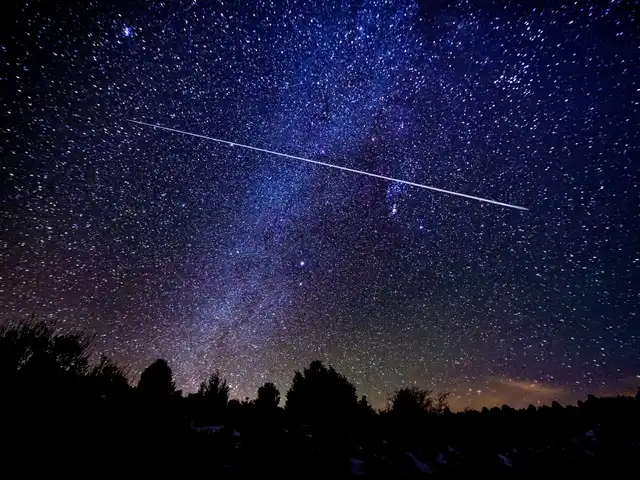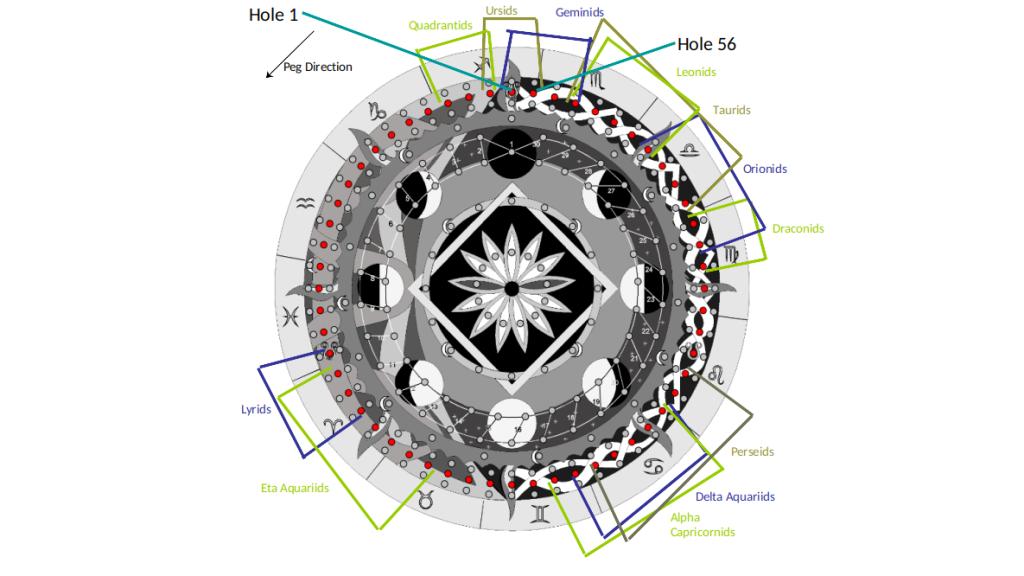
For a simple parapegma, the Druidcraft Calendar can be used to track and predict an impressive array of astronomical phenomena. In this article, I would like to introduce yet another use for the calendar; The prediction of meteor showers. As with all Druidcraft Calendar usage for predictions, the key is a little astronomical knowledge.
Just as the Earth and other planets orbit the sun, so too do comets. As these comets travel along their orbits they leave behind trails of dust particles, which are know as meteor streams. Some of these meteor streams intersect the Earth’s orbit, and when the earth passes through them, we experience a meteor shower.
Now because these streams intersect the earth’s orbit at specific points, we experience these showers at the same time each year. This means that it is extremely easy to plot these meteor showers on the sun ring of the calendar, as it is a representation of the solar year, or the earth’s orbit around the sun.
Below are details for annual meteor showers for the northern hemispheres, and when to watch out for them.
| Shower Name | Point of Maximum | Normal Limits | Hourly rate | Description |
|---|---|---|---|---|
| Ursids | Hole 1 | Hole 56-2 | 10 | Sparse shower. Associated with comet 8P/Tuttle and Radiating from the constellation of Ursa Minor. |
| Quadrantids | Hole 3 | Hole 2-4 | 110 | Bluish- or yellowish-white meteors with fine trains radiating from the constellation of Bootes. |
| Lyrids | Hole 20 | Hole 18-21 | 18 | Bright fast meteors, some with trains. Associated with Comet Thatcher. Oldest recorded meteor shower still visible today, first recorded 687BC, radiating from the constellation of Lyra, the lyre. |
| Eta Aquariids | Hole 22 | Hole 19-25 | 50 | Low in the eastern sky. Associated with Comet Halley and originating in the constellation Aquarius near the start Eta Aquarii. |
| Delta Aquariids | Hole 35 | Hole 32-37 | 25 | Steady stream of meteors over several days but a low rate per hour, radiating from the constellation of Aquarius near the star Delta Aquarii. |
| Alpha Capricornids | Hole 35 | Hole 31-37 | 5 | Yellow slow fireballs, expected to become much stronger in the coming centuries, originating in the constellation of Capricorn. |
| Perseids | Hole 37 | Hole 33-39 | 100 | Many bright fast meteors with trains. Associated with Comet Swift-Tuttle. One of the most spectacular meteor showers, radiating from the constellation of Perseus. Known in Ireland as “The games of Lugh”, coinciding with Lughnasadh. |
| Draconids | Hole 45 | Hole 44-46 | 10 | Associated with Comet 21/P Giacobini-Zimmer. High in the sky radiating from the constellation of Draco. Usually a sleepy meteor shower, but every so often the dragon awakes and this shower becomes very active. |
| Orionids | Hole 47 | Hole 45-50 | 25 | Fast with fine trains. Associated with Comet Halley and appearing all over the sky, but radiating from the constellation of Orion. |
| Taurids | Hole 51 | Hole 47-55 | 5 | Very slow meteors, associated with the comet Encke and lasting almost 2 months. Radiates from the constellation of Taurus. |
| Leonids | Hole 52 | Hole 50-54 | 10 | Fast bright meteors with fine trains. Associated with Comet Tempel-Tuttle, radiating from the head of Leo the lion. Approximately every 33 years this shower is particularly spectacular, with the next expected storm to be 2032/2033 |
| Geminids | Hole 56 | Hole 54-1 | 150 | Plenty of bright meteors, few trains, and thought to be intensifying each year. The shower radiates from the constellation of Gemini near the star Castor. |

Where the meteor shower originates from a constellation of the zodiac such as Aquarius, Capricorn, Taurus, Leo or Gemini, then the calendar can also be used to point at the area of the sky the shower radiates from.
To use the calendar to find the zodiac constellation you simply stand facing south and rotate the calendar until the moon peg aligns with the moon in the sky. The zodiac on the outside of the the calendar will then also be aligned with the sky, so you can simply look in the direction indicated of the constellation on the calendar to find the radiant point of the meteor shower.